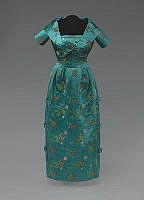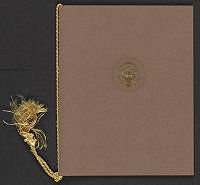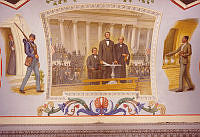Rubenstein Center Scholarship
The Enslaved Households of President Zachary Taylor
This article is part of the Slavery in the President’s Neighborhood initiative. Explore the Timeline
It does not speak well, either for the independence of the United States, or for the civic virtues of its leading men, that none by soldiers or slaveholders are deemed worthy of its presidential chair…sometimes they have united them in the same person, as in the cases of George Washington and Zachary Taylor.
Born in 1784, Zachary Taylor grew up on a plantation in Virginia. His father, Richard Taylor, was an officer in the Continental Army and a southern planter. About six years later, Colonel Taylor purchased Springfield plantation and moved his family to Louisville, Kentucky, and by 1800, Taylor had expanded his slaveholdings to twenty-six enslaved people.1 Zachary Taylor lived at his father’s plantation until he left to join the military in 1808. Two years later, he married Margaret Mackall Smith, daughter of wealthy tobacco plantation owner Walter Smith, from Calvert County, Maryland.2

Taylor Home in Kentucky—built and maintained by enslaved labor.
The Presidents of the United States, 1789-1914 by James Grant WilsonWhen Richard Taylor died in 1829, Zachary inherited two enslaved men, Charles and Tom, who remained with him until his death in 1850.3 In 1842, Taylor purchased Cypress Grove, a plantation in Rodney, Mississippi, though he already owned plantations farmed by enslaved labor elsewhere in Mississippi, as well as in Baton Rouge, Louisiana.4 In addition to the acreage, crops, and resources deeded to Taylor in his purchase of Cypress Grove, he also bought the following eighty-one enslaved men, women, and children:
Nelson, Milley, Peldea, Mason, Willis, Rachel, Caroline, Lucinda, Ramdall, Wirman, Carson, Little Ann, Winna, Jane, Tom, Sally, Gracia, Big Jane, Louosa, Maria, Charles, Barnard, Mira, Sally, Carson, Paul, Sansford, Mansfield, Harry Oden, Harry Horley, Carter, Henrietta, Ben, Charlotte, Wood, Dick, Harrietta, Clarissa, Ben, Anthony, Jacob, Hamby, Jim, Gabriel, Emeline, Armstead, George, Wilson, Cherry, Peggy, Walker, Jane, Wallace, Bartlett, Martha, Letitia, Barbara, Mathilda, Lucy, John, Sarah Bigg Ann, Allen, Tom, George, John, Dick, Fielding, Nelson or Isom, Winna, Shellod, Lidney, Little Cherry, Puck, Sam, Hannah or Anna, Mary, Ellen, Henrietta, and two small children.5
Taylor gained national prominence after several key victories in the Mexican-American War (1846-1848). He went on to win the election of 1848 and assumed the presidency as the country was heading toward another crisis over the issue of slavery. A slave owner himself, President Taylor adopted some antislavery political positions. He opposed the spread of slavery to new U.S. territories. However, he also vacillated over supporting the Wilmot Proviso, a rider which prohibited slavery in any territory acquired from Mexico following the Mexican-American War.6 Although he was considered more of an antislavery president by his contemporaries, Taylor had no qualms arguing against slavery’s expansion while owning hundreds of enslaved men, women, and children.7 He continued to own and manage his Cypress Grove plantation in Mississippi during his short tenure as president, and he is believed to be the last president who brought enslaved men and women to live and work at the White House.

A depiction of one of Zachary Taylor's plantations.
Henry Lewis, Das illustrirte Mississippithal (1857)Like other slaveowning presidents, Taylor brought enslaved individuals to the White House to provide labor. However, Taylor owned so many individuals, spread across several plantations in the South that it is challenging to discern the exact identities or number of enslaved workers Taylor actually brought with him to the White House.8 In addition, few of Zachary Taylor’s papers survive. In 1862, his plantation, Fashion, inherited by his son after his death, was confiscated and emptied by Union troops. Almost all of the personal papers and artifacts documenting Taylor’s life were lost during Union occupation.9 These factors, coupled with Taylor’s relatively short tenure as president, make it difficult to uncover the extent of slavery in the White House during his administration.
Despite these obstacles, records point to some individuals that likely accompanied Taylor to the White House. One confirmed individual was Charles Porter, who was a “body servant” to Taylor. In 1849, newspapers reported that Porter, “who accompanied him during the war with Mexico, died suddenly on Sunday morning at the Executive Mansion.”10
In his will, Taylor left six enslaved people to First Lady Margaret Taylor, perhaps suggesting these individuals were favored by the couple, and therefore likely to have worked in the White House. These enslaved individuals include Charles Porter, as well as Tom, Dicey, Jane, William and Caroline.11 Military pay vouchers from the Mexican-American War indicated that Charles, Tom, Jane and William (or Will) also accompanied Taylor during military encampments prior to his presidency.12 The consistent appearance of their names in these documents suggests that they likely would have accompanied him to the White House.

This is a newspaper clipping from the August 1, 1849 issue of the Alexandria Gazette, detailing the death of Charles, President Taylor's enslaved body servant.
Library of CongressIn 1862, Jane is again mentioned alongside two other enslaved individuals named Nancy and Henrietta in petition forms filed by Taylor’s daughter, Ann Wood. These forms, which allowed slave owners to claim compensation for enslaved individuals after the passage of emancipation in Washington, D.C., recorded that Ann Wood: "inherited Jane Webb from her late mother Mrs. Margaret Taylor relict of General Z Taylor…Henrietta Evans under the same circumstances (by inheritance)…she came into possession of Nancy Reed by a deed of gifts and by inheritance from her late father Genl. Zachary Taylor."13
In this petition, Wood described them as “first class family servants…always having been employed in that capacity in the family of your petitioner…Jane is an excellent cook… all three are good seamstresses.”14 The domestic nature of these tasks is the type of labor that would have been required in the Taylor White House.
Betty Bliss, Taylor’s daughter, and her husband, William Wallace Smith Bliss, also lived in the White House during the Taylor administration and may have brought their enslaved workers to assist with the household labor. In 1849 and 1850, while Bliss worked for and lived with Taylor, he submitted army pay vouchers for enslaved individuals named Lawrence Smith, Eliza Smith, and Eli.15 Lawrence, Eliza, and Eli very likely worked and lived at the White House under Bliss’s management.

Taylor is depicted in this political cartoon attempting to balance southern rights and the Wilmot Proviso.
Library of CongressWhile living in Washington, D.C., Taylor was an absentee but active plantation owner. He frequently visited Cypress Grove in Mississippi and constantly wrote to his hired overseer, Thomas W. Ringgold, to ensure the estate’s smooth operation while he was away. In these letters, Taylor often mentioned enslaved laborers at Cypress Grove. He wrote about the livelihood of what he called his “servants,” once telling Ringgold “Let your first consideration be the health of the servants,” and instructing that $5 be distributed to each enslaved laborer on Christmas Day.16 These narratives of the “benevolent slaveholder,” repeated in biographies and articles about Taylor since his death, have veiled his striking contribution to and perpetuation of slavery as an institution, and should be interpreted as such—especially because “fair” treatment of enslaved populations ensured smooth plantation operations and men and women better equipped for labor.17 Feeding the enslaved well or keeping morale high was a shrewd business choice on the part of Taylor, rather than an act of paternalism or compassion.
Zachary Taylor died only sixteen months into his presidency, and as such the American populace celebrated his memory as a military leader and president. However, he also left behind a legacy of plantations maintained by enslaved labor. In fact, Taylor purchased a plantation for his son, Fashion in Louisiana, just before his death in 1850, and bought an additional sixty-four enslaved people to work the land.18 Maintaining slavery was one of his final acts in life. In his will, approximately 131 enslaved men, women, and children, ranging in age from infants to the elderly, were left to Taylor’s wife Margaret; daughters Ann and Betty; and his son Richard. Taylor also noted in his will: “I wish the servants only moderately worked and kindly treated and the old men taken good care of and made comfortable, which I hope my children will have attended to.”19 Despite this paternalistic tone, Zachary Taylor failed to free any of these enslaved individuals after his death. Instead, he prolonged their bondage and suffering, designating in his will that these men, women, and children were to be “slaves for life.” Thankfully, this would not be the case for all of the individuals held in bondage by the Taylor family. Nancy, Henrietta, and Jane are verifiable examples of eventual emancipation, and after the confiscation and ransacking of Taylor’s plantation during the Civil War, many of the men and women held in bondage by Taylor’s descendants escaped to freedom.










